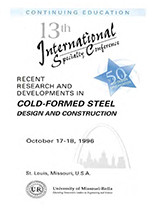Session Dates
17 Oct 1996
Abstract
Current specification procedures for calculating the bending strength of members with multiple longitudinal intermediate stiffeners in the compression flange have been found to be inadequate. A new procedure for calculating the effective width of stiffened elements with multiple intermediate stiffeners is presented. The new method introduces the calculation of a buckling coefficient for overall buckling of the entire stiffened element as a unit, and local buckling of the subelement plates between stiffeners. The expression for calculating overall buckling is derived and verified via comparison to numerical methods. The minimum buckling coefficient from the two modes (local and overall) is used to calculate the critical buckling stress for the element. Using Winter's equation the effective width of the element is determined. The effective width is distributed as two strIps at the corners, in a manner similar to elements without· intermediate stiffeners. The resulting section is found to be a reliable predictor of the bending strength of members with multiple intermediate stiffeners in the compression flange.
Department(s)
Civil, Architectural and Environmental Engineering
Research Center/Lab(s)
Wei-Wen Yu Center for Cold-Formed Steel Structures
Meeting Name
13th International Specialty Conference on Cold-Formed Steel Structures
Publisher
University of Missouri--Rolla
Document Version
Final Version
Rights
© 1996 University of Missouri--Rolla, All rights reserved.
Document Type
Article - Conference proceedings
File Type
text
Language
English
Recommended Citation
Schafer, Benjamin W. and Pekoz, Teoman, "Design of Cold-formed Steel Stiffened Elements with Multiple Longitudinal Intermediate Stiffeners" (1996). CCFSS Proceedings of International Specialty Conference on Cold-Formed Steel Structures (1971 - 2018). 2.
https://scholarsmine.mst.edu/isccss/13iccfss/13iccfss-session1/2
Design of Cold-formed Steel Stiffened Elements with Multiple Longitudinal Intermediate Stiffeners
Current specification procedures for calculating the bending strength of members with multiple longitudinal intermediate stiffeners in the compression flange have been found to be inadequate. A new procedure for calculating the effective width of stiffened elements with multiple intermediate stiffeners is presented. The new method introduces the calculation of a buckling coefficient for overall buckling of the entire stiffened element as a unit, and local buckling of the subelement plates between stiffeners. The expression for calculating overall buckling is derived and verified via comparison to numerical methods. The minimum buckling coefficient from the two modes (local and overall) is used to calculate the critical buckling stress for the element. Using Winter's equation the effective width of the element is determined. The effective width is distributed as two strIps at the corners, in a manner similar to elements without· intermediate stiffeners. The resulting section is found to be a reliable predictor of the bending strength of members with multiple intermediate stiffeners in the compression flange.



